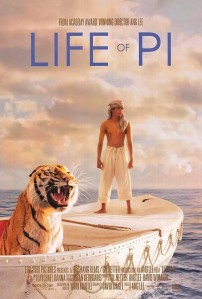By: Addison Wylie
I shouldn’t be exiting a theatre shrugging my shoulders and issuing “meh’s” after watching the much anticipated Life of Pi.
It’s a movie with a massive magnitude of talent both in front and behind the camera, wild surreal imagery that I imagine is a trip in 3D (I saw it in traditional 2D), and a strong story of a young boy who’s beliefs in many religions helped him to survive on a lifeboat with an unpredictable Bengal tiger.
However, I was underwhelmed and left feeling disappointed in the final product orchestrated by director Ang Lee.
The problem that Life of Pi has, unfortunately, grips onto other aspects about the film causing the flaw to conquer the movie – its visuals.
Don’t get me wrong, Lee has a way with telling a story through surreal images – and some of them are highly effective. When young Pi Patel (played by Suraj Sharma) is stranded on a lifeboat and the day turns to night, the water mirrors the sky positioning the lone boat in the ultimate situation of being in the middle of nowhere.
On one night, the water is filled with jellyfish – miles and miles of them. In a similar fashion audiences saw in Avatar, the jellyfish glow on different beats making for an attractive scene. We then get a hallucinogenic free fall through Pi’s thoughts as he gazes into the waters. Multiple animals and stars come zooming past us and, sometimes, form pictures.
But, most of the visuals cripple Life of Pi. Lee has CGI’d most of his animals and most of the tiger’s performance. I can see why.
Lee has to call on his cast of different animals to do certain things. Things like picking up objects and staring at them, fighting with animalistic foes, and giving off human emotion. It would take the world’s best animal trainer and years and years of practice in order to get live animals to perform these directions. For that, I give Lee an obvious pass.
What I don’t give him a pass on is how the animals look. Visual presentation is like humour – it’s subjective. I saw Life of Pi with my wife who thought the animals were some of the most realistic animation she has seen recently. As for myself, I couldn’t help but be reminded of the Madagascar films and, weirdly enough, Disney’s flop The Wild.
To me, the animated elements were too cartoony. When the animals would move, they would move as if they were paying homage to Hannah-Barbara. It’s a choice in animation that has a hard time gelling because we’ve been immersed in a real-life world for the first third of the film.
In the film’s defence, Life of Pi is being told to audiences through the lead (now much older) and it’s understandable some attributes of the story would be exaggerated when being told to someone else. When was the last time you told a story where you elaborated just a tad?
It’s just too cartoony for my tastes. Life of Pi just doesn’t get away with it.
And, what about the excessive use of Chroma key? In order to shoot the creative visuals, green screen would’ve definitely had to be a key element. However, in some shots, the background cropping around the actors becomes too evident and we end up being reminded that this is a movie.
The storm sequences may be impressive at first glance but because of this distraction, we never feel any danger for Sharma (who does a pretty good job performing a one-man show in a fabricated environment).
I feel like Dr. Jekyl and Mr. Hyde when describing my feelings for Lee’s latest. So, here’s my final word: Life of Pi should’ve been animated from start to finish.
By having the film be animated through and through, the distractions caused by the cartoony animals and the obvious Chroma key would’ve vanished because the style would’ve been more consistent. Lee could’ve still gotten the results he wanted if he took this route and maintained the intensity of this captivating story, I have no doubt.
However, at the end of the day, we have this – which is just “ok”.




Leave a comment